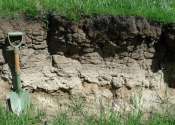Mountain erosion may add CO2 to the atmosphere
Scientists have long known that steep mountain ranges can draw carbon dioxide (CO2) out of the atmosphere—as erosion exposes new rock, it also starts a chemical reaction between minerals on hill slopes and CO2 in the air, ...








